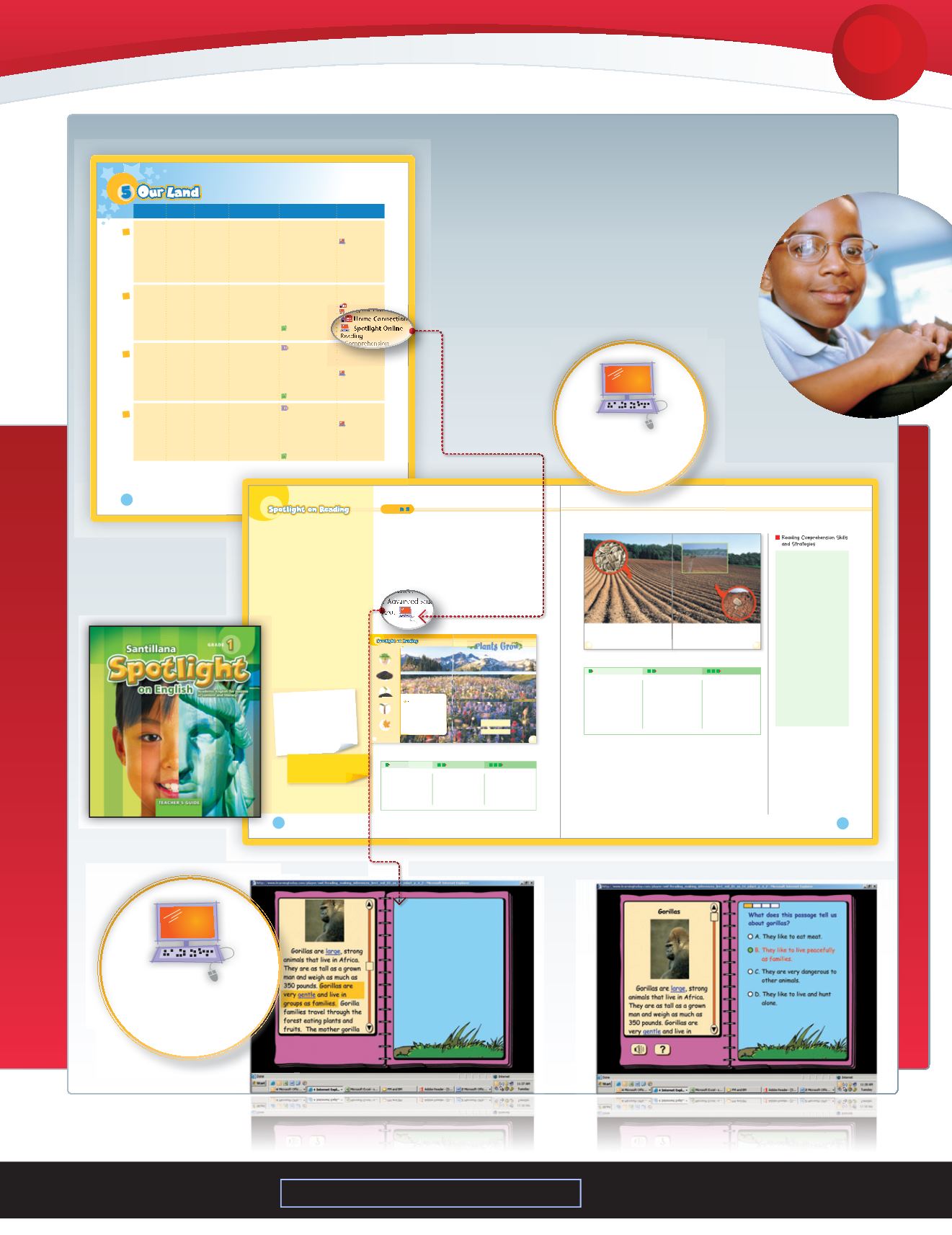

P
R
A
C
T
I
C
E
A
N
D
R
E
I
N
F
O
R
C
E
M
E
N
T
I
N
E
V
E
R
Y
L
E
S
S
O
N
W
I
T
H
S
P
O
T
L
I
G
H
T
O
N
L
I
N
E
!
21
INTERACTIVE
AND ENGAGING
SPOTLIGHT ONLINE
ACTIVITIES
Unit 5
Our Land
220
Lessons
Key
Vocabulary
Language
Functions
Materials
Instruction
Extended Activities
leaf
plant
soil
sprout
stem
Lesson 1
(TGpages
224–225)
Spotlight
onReading
Multiple Intelligences
Bodily/Kinesthetic
ThePlant andMe
SpotlightOnline
Reading
Comprehension:
Making Predictions:
L1:Vol.1
Q
Identifying
seasons
Q
Describing the
weather
Earth
PhotoCards
Blackmarkers
chartpaper
Brainstorm
ORAL
LANGUAGE
DEVELOPMENT
FrontloadVocabulary
WRITING
STRATEGIES
Let’sPredict!
ORAL
FLUENCY
Targeting Proficiency Levels
Meeting IndividualNeeds
PictureRead the Story
VOCABULARY
DEVELOPMENT
Predictions
ORAL
FLUENCY
U N I T P L A N N E R
Day
1
U
n
i
t
desert
flower
mountain
nectar
ocean
pollen
rain
root
spring
Lesson 2
(TGpages
226–231)
Spotlight
onReading
Multiple Intelligences
Naturalist
Caring forPlants
HomeConnection
SpotlightOnline
Reading
Comprehension:
Making Inferences,
Fact or Fiction: L1
Vol.1
Q
Describing
what aplant
needs
Q
Usingpresent
simple tense
PracticeBook (page 61)
Earth
PhotoCards
BlacklineMasters 5.1 and
5.2
white constructionpaper
crayons
ReviewVocabulary
VOCABULARY
DEVELOPMENT
Read andDiscuss the Story
READING
COMPREHENSION
FavoritePlantChart
ORAL
LANGUAGE
DEVELOPMENT
PersonalResponse
LITERARY
RESPONSE
Let’sPractice!
Day
2
flower
leaf
root
seed
sprout
stem
Lesson 3
(TGpages
232–233)
Spotlight
onReading
Multiple Intelligences
Logical/Mathematical
MeasuringPlants
Materials: Ruler,white
paper,markers
SpotlightOnline
PhonemicAwareness:
Addition: LA:Vol.1
Q
Describing
stagesofplant
growth
PracticeBook (page 62)
Class
CD (Track 28)
EchoRead the Story
CONCEPTS
ABOUT
Let’sCheck!
READING
COMPREHENSION
Targeting Proficiency Levels
Meeting IndividualNeeds
Act ItOut
LITERARY
RESPONSE
Sound ItOut
WORD
RECOGNITION
Let’sPractice!
Day
3
recycle
soil
sunlight
trash
water
Lesson 4
(TGpages
234–235)
Spotlight
onReading
Multiple Intelligences
Interpersonal
Save the EarthPosters
SpotlightOnline
Basic SightWords: L1:
Vol.13
Q
Recognizing
plantneeds
Q
Caring for the
earth
PracticeBook (page 63)
Class
CD (Track 28)
GroupReading
CONCEPTS
ABOUT
Let’s Summarize!
LITERARY
RESPONSE
Targeting Proficiency Levels
Meeting IndividualNeeds
Let’sReflect!
ORAL
FLUENCY
Targeting Proficiency Levels
Meeting IndividualNeeds
Let’sPractice!
Day
4
SpotlightTG1U5.indd 220
KeyVocabulary
desert
nectar
rain
flower
ocean
root
mountain
pollen
spring
Functions and Forms
Q
Describingwhat aplantneeds
The plant needswater.
Q
Usingpresent simple tense
Roots grow into the soil.
English LanguageDevelopment Skills
Listening
+
Listen attentively.
Speaking
+
Usedescriptivewords.
+
Retell stories and the sequence of story events.
+
Askquestions.
Reading
+
Matchoralwords toprintedwords.
+
Relateprior knowledge to textual information.
+
Retell the central ideas of simple expository
passages.
+
Respond to
who
,
what
,
where
, and
how
questions.
Review Vocabulary
VOCABULARY
DEVELOPMENT
Display the
Earth
Photo Cards that showweather. Elicit from students the
names of the seasons and the types ofweathermost frequently associated
with each season.
Read and Discuss the Story
READING
COMPREHENSION
StudentBook pages 128–129: Read the story aloudwhile students follow
along in their books.Use theDiscuss questions to develop comprehension
and language skills. Encourage beginning students to respondwith phrases
or simple sentences. Intermediate students should respond in complete
sentences. Advanced students should support their answerswith details
from the text.
Unit 5
Our Land
226
Lesso
n 2
Materials
Practice Book (page 61)
Earth
PhotoCards
BlacklineMasters5.1 and5.2
white constructionpaper
crayons
largepicture ofplantwithparts
labeled (from Lesson 1)
Beginning
Intermediate
Advanced
Pages128 and129
X
What season is
represented in this
photo?
X
What is theweather
like in the photo?
Page 129
X
What do you see in
the distance of the
photo?
X
What else do you
see in the photo?
Page129
X
Howwould you
describe this photo?
X
What animals do
you think live here?
Discuss
&'-
Jc^i*
;XW\TQOP\WV:MILQVO
plant
soil
sprout
stem
leaf
@ZnLdgYh
AZi
’
hEgZY^Xi
Answerthequestions.
&#
What season is it in thispicture?
'#
What cluesdoes thepicturegive
youaboutwhat the storymight
beabout?
(#
Whatdoes the title tell you the
storymightbeabout?
)#
Whatdo the keywords tell you
the storymightbeabout?
&'.
Jc^i*
It is spring!
It is sunnyandwarm.
Sometimes it rains.
by Sarah Fash
illustratedbyWally Rodrguez
Preparation
Q
Photocopy BlacklineMasters 5.1
and 5.2 (1per student).
SpotlightTG1U5.indd 226
11/4/07 6:04:06PM
Our Land
Unit 5
227
A seed isplanted in the soil.
The seedwill grow intoaplant.
The seedneeds soilandwater.
Jc^i*
&(%
Roots grow out of the seed.
They growdeep into the soil.
The roots carry food from the soil
to the rest of theplant.
Jc^i*
&(&
Beginning
Intermediate
Advanced
Page 130
X
Where are seeds
planted?
X
What do seeds need?
Page 131
X
What grows out of a
seed?
X
What do roots carry?
Page 130
X
What kind of seeds do
you think these are?
X
Why do seeds need soil
andwater?
Page 131
X
Why does the plant
need roots?
Page 130
X
Whatwill happen to
the seed?
Page 131
X
Roots carry food from
the soil to the plant.
What else do roots do?
(They hold the plant in
place.)
Discuss
Making Inferences
Explain to students that they
make inferenceswhen they use
clues from the reading andwhat
they already know to figure out
something that isnotdirectly
stated or explained in the
reading.Have studentsmake
inferences about theweather.
For example:
Do you think seeds
could grow into a plant if itwere
cold and snowy?
Sequence
Explain to students that
sequence
is the order of events in a story.
Understanding inwhich order
events takeplace in a story is
essential to forming ideas and
opinions about a story.Words
andphrases such as
first
,
then
,
finally
,
the next day
,
tomorrow
,
etc.
often signal order of events
in a story.Help students identify
order of events in the storyby
having them identify stages in the
plant’s cycle. For example:
A seed
is planted in the soil. The seed
will grow into a plant.
SpotlightTG1U5.indd 227
11/4/07 6:06:48PM
Teacher’s Guide Level 1
Reading Comprehension: Making Inferences
SPOTLIGHT
ONLINE
ACTIVITIES
LEARN MORE BY VISITING
www.SPOTLIGHTONENGLISH.com or CALLING TOLL FREE 1-800-245-8584


















